Wētā
Wētā (also spelled weta) is the common name for a group of about 70 insect species in the families Anostostomatidae and Rhaphidophoridae, endemic to New Zealand.[1] They are giant flightless crickets, and some are among the heaviest insects in the world. Generally nocturnal, most small species are carnivores and scavengers while the larger species are herbivorous.[2] Wētā are preyed on by introduced mammals, and some species are now critically endangered.
| Wētā | |
|---|---|
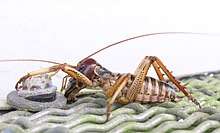 | |
| Male Wellington tree wētā | |
| Scientific classification | |
| Kingdom: | |
| Phylum: | |
| Class: | |
| Order: | |
| Suborder: | |
| Superfamily: | |
| Family: | |
Name
Wētā is a loanword, from the Māori word wētā, which refers to this whole group of large insects; some types of wētā (see below) have a specific Māori name.[3] In New Zealand English, it is spelled either "weta" or "wētā", although the form with macrons is increasingly common in formal writing, as the Māori word weta (without macrons) means "filth or excrement".[3][4]
General characteristics
Many wētā are large by insect standards[5] and some species are among the largest and heaviest in the world. Their physical appearance is like a katydid, long-horned grasshopper, or cricket, but the hind legs are enlarged and usually very spiny. Many are wingless. Because they can cope with variations in temperature, wētā are found in a variety of environments, including alpine, forests, grasslands, caves, shrub lands and urban gardens. They are nocturnal, and all New Zealand species are flightless. Different species have different diets. Most wētā are predators or omnivores preying on other invertebrates, but the tree and giant wētā eat mostly lichens, leaves, flowers, seed-heads, and fruit.[6][7]
Male giant wētā (Deinacrida sp.) are smaller than females and they show scramble competition for mates.[8] Tree wētā (Hemideina sp) males have larger heads than females and a polygynandrous mating system with harem formation and male-male competition for mates.[9] Ground wētā (Hemiandrus sp.) males provide nuptial food gifts when mating and females of some species provide maternal care.[10] Wētā eggs are laid in soil over the autumn and winter months and hatch the following spring. A wētā takes between one and two years to reach adulthood, and over this time will have to shed its skin around ten times as it grows.[11]
Wētā can bite with powerful mandibles. Tree wētā bites are painful but not particularly common. Tree wētā lift their hind legs in a defence displays to look large and spiky, but they will retreat if given a chance. Tree wētā raise their hind legs into the air in warning to foes, and then bring them down to stridulate. Pegs or ridges on the side of their abdomen are struck by a patch of fine pegs at the inner surface of their hind legs (femur) and this action makes a distinctive sound.[12] These actions are also used in defence of a gallery by competing males. The female wētā looks as if she has a stinger, but it is an ovipositor, which enables her to lay eggs inside rotting or mossy wood[13] or soil. Some species of Hemiandrus have very short ovipositors, related perhaps to their burrowing into soil and laying their eggs in a special chamber at the end of the burrow.[14]
Taxonomy and evolution
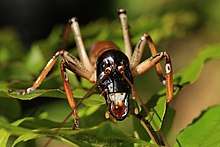
Fossilized orthopterans have been found in Russia, China, South Africa, Australia, and New Zealand, but the relationships are open to different interpretations by scientists. Most wētā of both families are found in the Southern Hemisphere. Wētā were probably present in ancient Gondwanaland before Zealandia separated from it.[15] Rhaphidophoridae dispersed over sea to colonise the Chatham Islands, the Auckland, Snares and Campbell Islands.[16] The present species might have resulted from a recent radiation, which conflicts with those earlier ideas about dispersal of wētā forebears around the Southern Hemisphere (Wallis et al. 2000).
Giant, tree, ground, and tusked wētā are all members of the family Anostostomatidae (formerly in the Stenopelmatidae, but recently separated).[17] Cave wētā are better referred to as tokoriro, since they are members of the family Rhaphidophoridae, called cave crickets or camel crickets elsewhere, in a different ensiferan superfamily. In New Zealand there were as of 2014 19 genera of tokoriri, and their taxonomy is under review.[18][19][20] Seven new species of South Island cave wētā have been named and described in 2019, including Pleioplectron rodmorrisi.[21]
There are other genera in the same superfamily (Stenopelmatoidea) in the southwest of North America. These are Jerusalem crickets belonging to the family Stenopelmatidae.
Species
Giant wētā
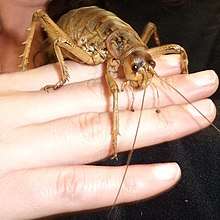
The 11 species of giant wētā (Deinacrida spp.) are endemic to New Zealand.[12] Giant wētā (wētā punga in Māori)[3] are large by insect standards. They are heavy herbivorous Orthoptera with a body length of up to 100 mm (3.9 in) excluding their lengthy legs and antennae, and weigh about 20–30 g. A captive giant wētā (Deinacrida heteracantha) filled with eggs reached a record 70 g, making it one of the heaviest documented insects in the world[22] and heavier than a sparrow. The largest species of giant wētā is the Little Barrier Island wētā, also known as the wētāpunga. Giant wētā tend to be less social and more passive than tree wētā (Hemideina spp.). They are classified in the genus Deinacrida, which is Greek for "terrible grasshopper". They are found primarily on small islands off the coast of the main islands or at high elevation on New Zealand's South Island (e.g. the alpine scree wētā D. connectens), and are sometimes considered examples of island gigantism.
Tree wētā
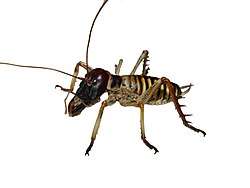
Tree wētā (Hemideina) are commonly encountered in suburban settings in New Zealand's North Island. They are up to 40 mm long and most commonly live in holes in trees formed by beetle and moth larvae or where rot has set in after a twig has broken off. The hole, called a gallery, is maintained by the wētā and any growth of the bark surrounding the opening is chewed away. They readily occupy a preformed gallery in a piece of wood (a "wētā motel") and can be kept in a suburban garden as pets. A gallery might house a harem of up to 10 adult females and one male.[9] Tree wētā are nocturnal. Their diet consists of plants and small insects.[7] The males have much larger jaws than the females, though both sexes will stridulate and bite when threatened.[12]
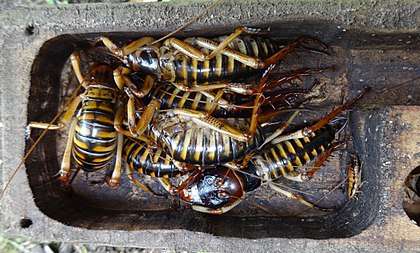
The seven species of tree wētā (pūtangatanga in Māori)[3] are:
- The Auckland tree wētā Hemideina thoracica can be found throughout the North Island apart from the Wellington-Wairarapa region. Within this range are seven chromosome races.[23]
- The Wellington tree wētā Hemideina crassidens occupies Wellington, the Wairarapa, the northern parts of the South Island, and the West Coast.[24]
- Hemideina trewicki is found in Hawke's Bay.[25]
- H. femorata is found in Marlborough and Canterbury.
- The rare H. ricta species occurs in Banks Peninsula.
- The West Coast bush wētā H. broughi largely overlaps with the Wellington tree wētā in Nelson and the northern portion of the West Coast.
- H. maori, the mountain stone wētā, lives above the tree line in the Southern Alps.
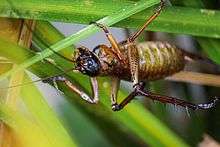
The North Island species each have a distinctive set of chromosomes (karyotype).[26] When the territories of species overlap, as with the related species H. femorata and H. ricta on Banks Peninsula, they may interbreed, although offspring are sterile.[27]
Tusked wētā
Tusked wētā are characterised by long, curved tusks projecting forward from the male's mandibles. The tusks are used in male-to-male combat, not for biting. Female tusked wētā look similar to ground wētā. Tusked wētā are mainly carnivorous, eating worms and insects. There are three known species in two different subfamilies: the Northland tusked wētā Anisoura nicobarica (originally described as a ground wētā, Hemiandrus monstrosus), in the subfamily Deinacridinae; the Mercury Islands tusked wētā Motuweta isolata; and the most recently discovered, the Raukumara tusked wētā Motuweta riparia. Motuweta is in the same subfamily as ground wētā, Anostostomatinae.
The Northland tusked wētā lives in tree holes, similar to tree wētā. The Mercury Islands or Middle Island tusked wētā was discovered in 1970. It is a ground-dwelling wētā, entombing itself in shallow burrows during the day, and is critically endangered: a Department of Conservation breeding programme has established new colonies on other islands in the Mercury group. The Raukumara tusked wētā was discovered in 1996, in the Raukumara Range near the Bay of Plenty. It has the unusual habit of diving into streams and hiding underwater for up to three minutes if threatened.
Ground wētā
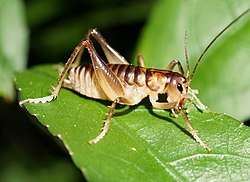
Ground wētā are classified in the genus Hemiandrus. About 30 species of ground wētā occur in New Zealand, and several very similar (undescribed) ones are found in Australia.[17] They are also very like the Californian Cnemotettix—a similarity perhaps due to their very similar habits and habitat. 14 Hemiandrus species have been described from New Zealand[28] and other distinct populations require further study.[29] They hide in burrows in the ground during the day, and those that live in open ground (e.g., H. focalis, H. maia)[30] conceal their exit holes with a specially made perforated door. During the night, ground wētā hunt invertebrate prey and eat fruit. Most female ground wētā have long ovipositers (e.g. H. maculifrons), but some have short ovipositers and maternal care (e.g. H. maia, H. pallitarsis).
Cave wētā
The 60 species of cave wētā or tokoriro[3] are only very distant relatives of the other types of wētā, being classified in several genera of subfamily Macropathinae in family Rhaphidophoridae.
They have extra-long antennae, and may have long, slender legs and a passive demeanour. Although they have no hearing organs on their front legs like species of Hemideina and Deinacrida, some (such as Talitropsis) are very sensitive to ground vibrations sensed through pads on their feet. Specialised hairs on the cerci and organs on the antennae are also sensitive to low-frequency vibrations in the air.
Although some do live in caves, most species live in the forest among leaf litter, logs, tree holes and amongst broken rocks.[31][32] Cave-dwelling species may be active within the confines of their caves during the daytime, and those individuals close to cave entrances venture outside at night.[32]
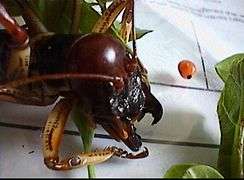 Face
Face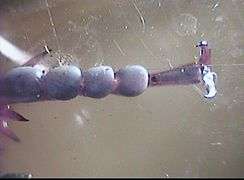 Lower leg (tarsus) with two claws and sensory pads
Lower leg (tarsus) with two claws and sensory pads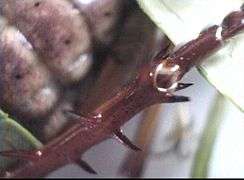 Upper leg
Upper leg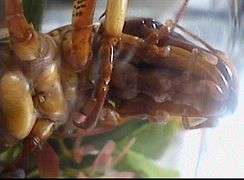 Underside with parasites
Underside with parasites
Conservation
Although wētā had native predators in the form of birds (especially the weka and kiwi), reptiles, and bats before the arrival of humans, introduced species such as cats, hedgehogs, rats (including kiore) and mustelids have caused a sharp increase in the rate of predation. They are also vulnerable to habitat destruction caused by humans and modification of their habitat caused by introduced browsers. New Zealand's Department of Conservation considers 16 of the 70 species at risk. Programmes to prevent extinctions have been implemented since the 1970s.
Some examples of especially endangered species are tracked by radio beacons.[33]
In popular culture
New Zealanders Peter Jackson, Richard Taylor, and Jamie Selkirk founded visual effects company Weta Digital, naming it after the insect.[34] There have been suggestions that Weta changes the spelling of its company name so it does not translate as "excrement".[4]
References
- Phoenix Group Evolutionary Ecology and Genetics (31 January 2020). "WētāGeta". Massey University. Retrieved 10 February 2020.
- Trewick, Steve; Morgan-Richards, Mary (2014). NZ wild life : introducing the weird and wonderful character of natural New Zealand. Auckland, New Zealand: Penguin. ISBN 9780143568896. OCLC 881301862.
- "Wētā". Te Aka Māori Dictionary. Retrieved 10 February 2020.
- Edmunds, Susan (13 September 2019). "Weta - when a macron means the difference between insects and excrement". Stuff. Retrieved 23 January 2020.
- Griffin, Melissa J.; Trewick, Steve A.; Wehi, Priscilla M.; Morgan-Richards, Mary (2011). "Exploring the concept of niche convergence in a land without rodents: the case of weta as small mammals". New Zealand Journal of Ecology. 35 (3): 302–307.
- Wehi, Priscilla M.; Hicks, Brendan J. (2010). "Isotopic fractionation in a large herbivorous insect, the Auckland tree weta". Journal of Insect Physiology. 56 (12): 1877–1882. doi:10.1016/j.jinsphys.2010.08.005. ISSN 0022-1910. PMID 20709068.
- Griffin, Melissa J.; Morgan-Richards, Mary; Trewick, Steve A. (2011). "Is the tree weta Hemideina crassidens an obligate herbivore?" (PDF). New Zealand Natural Sciences. 36: 11–19.
- Kelly, Clint D.; Bussière, Luc F.; Gwynne, Darryl T. (2008). "Sexual Selection for Male Mobility in a Giant Insect with Female‐Biased Size Dimorphism" (PDF). The American Naturalist. 172 (3): 417–423. doi:10.1086/589894. hdl:1893/914. ISSN 0003-0147. PMID 18651830.
- Wehi, Priscilla M.; Jorgensen, Murray; Morgan-Richards, Mary (2013). "Sex- and season-dependent behaviour in a flightless insect, the Auckland tree weta (Hemideina thoracica)". New Zealand Journal of Ecology. 37 (1): 75–83.
- Taylor Smith, B. L.; Morgan-Richards, Mary; Trewick, Steve A. (2013). "New Zealand ground wētā(Anostostomatidae: Hemiandrus): descriptions of two species with notes on their biology". New Zealand Journal of Zoology. 40 (4): 314–329. doi:10.1080/03014223.2013.804422.
- Gibbs, Gibbs (24 September 2007). "Story: Wētā, Tree wētā". Te Ara: The Encyclopedia of New Zealand. Retrieved 4 September 2012.
- Field, Laurence H. (2001). The biology of wetas, king crickets and their allies. Wallingford, Oxon., UK: CABI Pub. ISBN 9780851994086. OCLC 559432458.
- Kleinpaste, Ruud (1997). Scratching for a Living. Auckland: Random House NZ. ISBN 978-1869413279.
- Gwynne, Darryl T. (2005). "The secondary copulatory organ in female ground weta (Hemiandrus pallitarsis, Orthoptera: Anostostomatidae): a sexually selected device in females?". Biological Journal of the Linnean Society. 85 (4): 463–469. doi:10.1111/j.1095-8312.2005.00510.x. ISSN 0024-4066.
- Pratt, Renae C.; Morgan-Richards, Mary; Trewick, Steve A. (2008). "Diversification of New Zealand weta (Orthoptera: Ensifera: Anostostomatidae) and their relationships in Australasia". Philosophical Transactions of the Royal Society of London B: Biological Sciences. 363 (1508): 3427–3437. doi:10.1098/rstb.2008.0112. ISSN 0962-8436. PMC 2607373. PMID 18782727.
- "Rhaphidophoridae". wetageta.massey.ac.nz. Retrieved 16 August 2019.
- Johns, P. (1997). "The Gondwanaland weta: family Anostostomatidae (formerly in Stenopelmatidae, Henicidae or Mimnermidae): nomenclatural problems, world checklist, new genera and species". Journal of Orthoptera Research. 6 (6): 125–138. doi:10.2307/3503546. JSTOR 3503546.
- Cook, Lorraine D.; Trewick, Steven A.; Morgan-Richards, Mary; Johns, Peter M. (2010). "Status of the New Zealand cave weta (Rhaphidophoridae) genera Pachyrhamma, Gymnoplectron and Turbottoplectron". Invertebrate Systematics. 24 (2): 131–138. doi:10.1071/IS09047. ISSN 1447-2600.
- Trewick, Steve A. "Raphidophoridae". Weta Geta – Massey University. Retrieved 27 July 2018.
- Trewick, Steven A.; Hegg, Danilo; Morgan-Richards, Mary; Fitness, Josephine L. (2018). "Reinstatement of the New Zealand cave wētā genus Miotopus Hutton (Orthoptera: Rhaphidophoridae) and description of a new species". European Journal of Taxonomy. 0 (468). doi:10.5852/ejt.2018.468. ISSN 2118-9773.
- "Seven new South Island cave wētā identified". Stuff. Retrieved 25 November 2019.
- "Book of Insect Records". Archived from the original on 3 July 2006. Retrieved 20 May 2006.
- Morgan-Richards, M (1997). "Intraspecific karyotype variation is not concordant with allozyme variation in the Auckland tree weta of New Zealand, Hemideina thoracica (Orthoptera: Stenopelmatidae)". Biological Journal of the Linnean Society. 60 (4): 423–442. doi:10.1006/bijl.1996.0114.
- Bulgarella, Mariana; Trewick, Steven A.; Minards, Niki A.; Jacobson, Melissa J.; Morgan-Richards, Mary (2013). "Shifting ranges of two tree weta species (Hemideina spp.): competitive exclusion and changing climate". Journal of Biogeography. 41 (3): 524–535. doi:10.1111/jbi.12224. ISSN 0305-0270.
- Morgan-Richards, M (1995). "A new species of tree weta from the North Island of New Zealand (Hemideina: Stenopelmatidae: Orthoptera)". New Zealand Entomologist. 18: 15–23. doi:10.1080/00779962.1995.9721996.
- Mckean, NE; Trewick, SA; Morgan-Richards, M (2015). "Comparative cytogenetics of North Island tree wētā in sympatry". New Zealand Journal of Zoology. 42 (2): 73–84. doi:10.1080/03014223.2015.1032984. ISSN 0301-4223.
- Mckean, Natasha E.; Trewick, Steven A.; Morgan-Richards, Mary (2016). "Little or no gene flow despite F1hybrids at two interspecific contact zones". Ecology and Evolution. 6 (8): 2390–2404. doi:10.1002/ece3.1942. ISSN 2045-7758. PMC 4783458. PMID 27066230.
- Taylor-Smith, B. L.; Trewick, S. A.; Morgan-Richards, M. (2016). "Three new ground wētā species and a redescription of Hemiandrus maculifrons". New Zealand Journal of Zoology. 43 (4): 363–383. doi:10.1080/03014223.2016.1205109. ISSN 0301-4223.
- Johns, Peter (2001). "Distribution and conservation status of ground weta, Hemiandrus species (Orthoptera: Anostostomatidae)". Science for conservation. 180 – via New Zealand Department of Conservation.
- Smith, BL Taylor; Morgan-Richards, M.; Trewick, S. A. (2013). "New Zealand ground wētā (Anostostomatidae: Hemiandrus): descriptions of two species with notes on their biology". New Zealand Journal of Zoology. 40 (4): 314–329. doi:10.1080/03014223.2013.804422. ISSN 0301-4223.
- "Cave Weta Ecology". Weta Geta. Massey University. Retrieved 25 February 2017.
- Richards, Aola M. (1961). "Some Observations on New Zealand Cave-wetas". Tuatara. 9 (2): 80–83.
- "Eel's costly snack". The New Zealand Herald. 16 May 2009. Retrieved 3 December 2011.
- "From a draughty hut to Hollywood: the rise of Peter Jackson's secretive animation giant". The Guardian. 21 October 2016.
Further reading
- Wallis, G. P.; Morgan-Richards, M.; Trewick, S.A. (2000). "Phylogeographical pattern correlates with Pliocene mountain building in the alpine scree weta (Orthoptera, Anostostomatidae)". Molecular Ecology. 9 (6): 657–666. doi:10.1046/j.1365-294x.2000.00905.x. PMID 10849282.
- Sherley, Greg H (1998). "Threatened Weta Recovery Plan" (PDF). Department of Conservation. Retrieved 7 November 2007.
- Bleakley, Craig; Stringer, Ian; Robertson, Alastair; Hedderley, Duncan (2006). Design and use of artificial refuges for monitoring adult tree weta, Hemideina crassidens and H. thoracica. Wellington, N.Z.: Science & Technical Pub., Dept. of Conservation. ISBN 9780478140620.
- Salmon, John T. (1956). "A Key to the Tree and Ground Wetas of New Zealand". Tuatara. 6 (1): 19–23.
- Ramløv, H. (2000) Aspects of cold tolerance in ectothermic animals. Journal of Human Reproduction. 15 (Suppl. 5): 26–46.
External links
- Wētā at the New Zealand Department of Conservation
- Wētā in Te Ara: The Encyclopedia of New Zealand
- Wētā Geta – a comprehensive guide to New Zealand Orthoptera